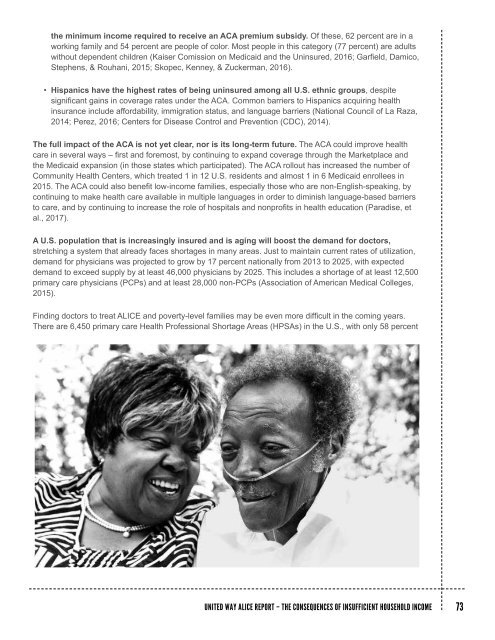The Consequences of Insufficient Household Income
This new Consequences of Insufficient Household Income report provides a deeper level of understanding of the choices that ALICE and poverty-level families across the country make when they do not have enough income or assistance to afford basic necessities, and the consequences of those choices.
This new Consequences of Insufficient Household Income report provides a deeper level of understanding of the choices that ALICE and poverty-level families across the country make when they do not have enough income or assistance to afford basic necessities, and the consequences of those choices.
You also want an ePaper? Increase the reach of your titles
YUMPU automatically turns print PDFs into web optimized ePapers that Google loves.
the minimum income required to receive an ACA premium subsidy. Of these, 62 percent are in a<br />
working family and 54 percent are people <strong>of</strong> color. Most people in this category (77 percent) are adults<br />
without dependent children (Kaiser Comission on Medicaid and the Uninsured, 2016; Garfield, Damico,<br />
Stephens, & Rouhani, 2015; Skopec, Kenney, & Zuckerman, 2016).<br />
• Hispanics have the highest rates <strong>of</strong> being uninsured among all U.S. ethnic groups, despite<br />
significant gains in coverage rates under the ACA. Common barriers to Hispanics acquiring health<br />
insurance include affordability, immigration status, and language barriers (National Council <strong>of</strong> La Raza,<br />
2014; Perez, 2016; Centers for Disease Control and Prevention (CDC), 2014).<br />
<strong>The</strong> full impact <strong>of</strong> the ACA is not yet clear, nor is its long-term future. <strong>The</strong> ACA could improve health<br />
care in several ways – first and foremost, by continuing to expand coverage through the Marketplace and<br />
the Medicaid expansion (in those states which participated). <strong>The</strong> ACA rollout has increased the number <strong>of</strong><br />
Community Health Centers, which treated 1 in 12 U.S. residents and almost 1 in 6 Medicaid enrollees in<br />
2015. <strong>The</strong> ACA could also benefit low-income families, especially those who are non-English-speaking, by<br />
continuing to make health care available in multiple languages in order to diminish language-based barriers<br />
to care, and by continuing to increase the role <strong>of</strong> hospitals and nonpr<strong>of</strong>its in health education (Paradise, et<br />
al., 2017).<br />
A U.S. population that is increasingly insured and is aging will boost the demand for doctors,<br />
stretching a system that already faces shortages in many areas. Just to maintain current rates <strong>of</strong> utilization,<br />
demand for physicians was projected to grow by 17 percent nationally from 2013 to 2025, with expected<br />
demand to exceed supply by at least 46,000 physicians by 2025. This includes a shortage <strong>of</strong> at least 12,500<br />
primary care physicians (PCPs) and at least 28,000 non-PCPs (Association <strong>of</strong> American Medical Colleges,<br />
2015).<br />
Finding doctors to treat ALICE and poverty-level families may be even more difficult in the coming years.<br />
<strong>The</strong>re are 6,450 primary care Health Pr<strong>of</strong>essional Shortage Areas (HPSAs) in the U.S., with only 58 percent<br />
UNITED WAY ALICE REPORT – THE CONSEQUENCES OF INSUFFICIENT HOUSEHOLD INCOME<br />
73




